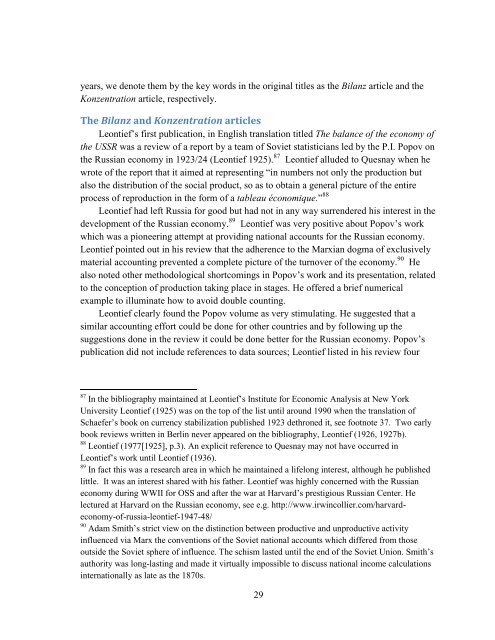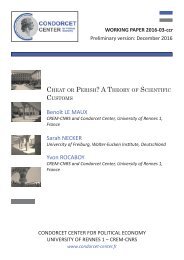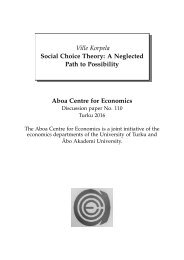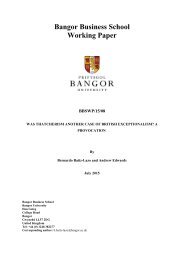MEMORANDUM
n?u=RePEc:hhs:osloec:2016_018&r=hpe
n?u=RePEc:hhs:osloec:2016_018&r=hpe
You also want an ePaper? Increase the reach of your titles
YUMPU automatically turns print PDFs into web optimized ePapers that Google loves.
years, we denote them by the key words in the original titles as the Bilanz article and the<br />
Konzentration article, respectively.<br />
The Bilanz and Konzentration articles<br />
Leontief’s first publication, in English translation titled The balance of the economy of<br />
the USSR was a review of a report by a team of Soviet statisticians led by the P.I. Popov on<br />
the Russian economy in 1923/24 (Leontief 1925). 87 Leontief alluded to Quesnay when he<br />
wrote of the report that it aimed at representing “in numbers not only the production but<br />
also the distribution of the social product, so as to obtain a general picture of the entire<br />
process of reproduction in the form of a tableau économique.” 88<br />
Leontief had left Russia for good but had not in any way surrendered his interest in the<br />
development of the Russian economy. 89 Leontief was very positive about Popov’s work<br />
which was a pioneering attempt at providing national accounts for the Russian economy.<br />
Leontief pointed out in his review that the adherence to the Marxian dogma of exclusively<br />
material accounting prevented a complete picture of the turnover of the economy. 90 He<br />
also noted other methodological shortcomings in Popov’s work and its presentation, related<br />
to the conception of production taking place in stages. He offered a brief numerical<br />
example to illuminate how to avoid double counting.<br />
Leontief clearly found the Popov volume as very stimulating. He suggested that a<br />
similar accounting effort could be done for other countries and by following up the<br />
suggestions done in the review it could be done better for the Russian economy. Popov’s<br />
publication did not include references to data sources; Leontief listed in his review four<br />
87 In the bibliography maintained at Leontief’s Institute for Economic Analysis at New York<br />
University Leontief (1925) was on the top of the list until around 1990 when the translation of<br />
Schaefer’s book on currency stabilization published 1923 dethroned it, see footnote 37. Two early<br />
book reviews written in Berlin never appeared on the bibliography, Leontief (1926, 1927b).<br />
88 Leontief (1977[1925], p.3). An explicit reference to Quesnay may not have occurred in<br />
Leontief’s work until Leontief (1936).<br />
89 In fact this was a research area in which he maintained a lifelong interest, although he published<br />
little. It was an interest shared with his father. Leontief was highly concerned with the Russian<br />
economy during WWII for OSS and after the war at Harvard’s prestigious Russian Center. He<br />
lectured at Harvard on the Russian economy, see e.g. http://www.irwincollier.com/harvardeconomy-of-russia-leontief-1947-48/<br />
90 Adam Smith’s strict view on the distinction between productive and unproductive activity<br />
influenced via Marx the conventions of the Soviet national accounts which differed from those<br />
outside the Soviet sphere of influence. The schism lasted until the end of the Soviet Union. Smith’s<br />
authority was long-lasting and made it virtually impossible to discuss national income calculations<br />
internationally as late as the 1870s.<br />
29





